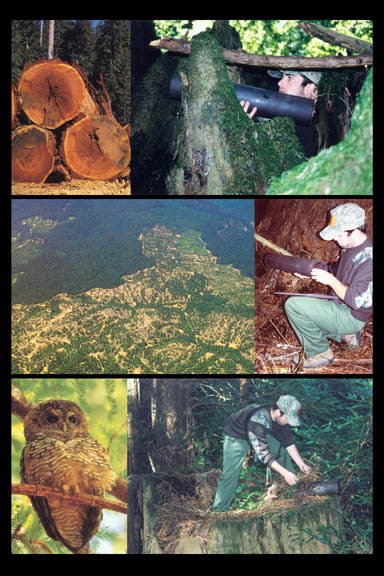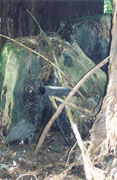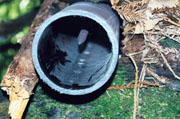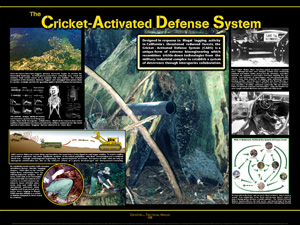

Cricket-Activated Defense System
Redefining Biotech in the Political Ecosystem.
The CADS project - designed in response to illegal logging activity in California's threatened redwood forests - is an accreted version of trickle-down technologies from the military/industrial complex which explores interspecies collaboration in the fight to save endangered environments. Relying on the crickets' unique audible responses to human encroachment as well as their strategic positioning on the borders between logged and unlogged regions, CADS establishes a system of deterrence through the technological augmentation of natural systems. Serving both as a critique of hegemonic logic and as a tactical tool for a disempowered community, CADS redefines "biotech" within a political ecosystem.
The CADS Project, or cricket-missile system, consists of three main components: 1) the technology, 2) the implementation/installation of the technology, and 3) the demonstration of the technology. The technology itself is an electronic device that receives distressed cricket chirps and translates the sound into a firing signal for anti-logger missiles. The device is a form of extreme bioengineering that simply recombines consumer surveillance products (essentially "bugging" devices) with model rockets - both trickle-down goods from the military-industrial complex.
Installation of CADS typically takes place along logging roads at the border between logged areas and old-growth, redwood forests currently threatened by illegal logging. Crickets are the ideal guardians of this area since they naturally take up the perimeter and have evolved to transmit a very precise frequency should they feel threatened by the encroachment of an invasive species. To avoid a misfire, the system is activated only when a significant number of the cricket population voice their consternation over a relatively broad area.
By technologically augmenting the natural responses of crickets, the success of CADS relies not only on interspecies collaboration but also on the collective efforts of a greatly disempowered community. This relationship is further highlighted in a public lecture/demonstration in which attendees from various disciplines (art, engineering, biology, environmental science, etc) gather to form an academic ecosystem. The CADS presentation explores cricket morphology, surveillance technology, and the political ecology of forestry before culminating in a cricket-assisted demonstration launch. Afterwards, the ensuing Q & A consistently encourages a lively discussion that engages militaristic rhetoric, political obfuscation, and the polemics of "violence" along with notions of creative resistance and interdisciplinary social practices.
This
performance-lecture/demonstration has been successfully enacted at the
University of California, Santa Cruz and will also be presented in late
February in the final panel at the College Art Association Conference
in New York.



(PDF - 5.25 MB):
